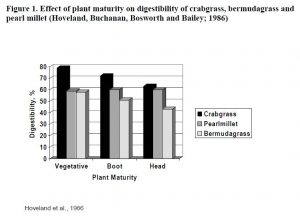By Jeremy Kichler
Colquitt County CEC
I have had forage producers love or hate crabgrass over the years. If you are a hay producer, crabgrass can provide us with some production challenges such as slower drying time compared to other summer forages. If you are in need of some summer grazing, it can be a blessing. Crabgrass is a low-growing annual grass that can establish quickly and can produce high quality, palatable forage. According to some references, the forage quality of crabgrass is typically higher than most summer grasses such as bermudagrass, bahiagrass, pearl millet and sorghum- sudan. Crabgrass has a high reseeding potential that can furnish summer grazing after winter annuals. Let’s discuss some points to consider about crabgrass in forage production systems.
There are several species of crabgrass that are found in the Southeast but we are going to discuss large or hairy crabgrass (Digitaria sanguinalis). This forage warm season annual has long stolons or runners that form roots at the nodes. This forage reseeds itself every year if it is allowed flower and produce seed. Crabgrass has a clump-like growth habit and can grow to 2 feet tall. Crabgrass can compete well with other plants in both grazing and haying situations because of its prostrate growth habit.
Crabgrass can be established in the early spring when soil temperatures stabilize around 58 degrees which would be around late February or early March depending on the year. Soil temperature information can be obtained at www.georgiaweather.net. If a producer has a pasture that contains large populations of crabgrass then a light harrow during this time could encourage emergence. If you have winter annuals in the forage program then time the tillage event in mid spring.
If you are establishing a stand of crabgrass, consider seeding rates in the 4-6 lb per acre range. According to UGA Forages, Red River crabgrass, a productive collection from an upland site north of the Red River in southern Oklahoma, is the only commercially-available variety and has not been adequately evaluated in Georgia. Forage producers can plant crabgrass into a firm seedbed that has been well prepared from March until May. In order to assist spreading or the flow through the grain drill, crabgrass can be mixed with carriers such as dry sand, or lime. Producers should prepared their seed beds with a cultipacker, since the seeding depth should be around ¼ inch deep for crabgrass. Crabgrass should not planted ½ inch or deeper. If you broadcast crabgrass, consider using a cultipacker after seeding to encourage good seed to soil contact. If good soil moisture is available at planting then a small amount of crabgrass seed germination will occur. The stand of crabgrass will continue to thicken over the first couple of months. It is possible for crabgrass to be 6 inches tall and ready to graze in about 30 days.
Producers need to start their fertility program with a soil sample. Crabgrass can produce forage in a soil pH from 5.5 to 7.5 and does respond well to nitrogen fertilization. Please be careful with nitrogen rates because of nitrate accumulations is possible during drier conditions. Total nitrogen rates should be in the 120 pounds per acre range depending on planting date, weather, and etc. Split applications of nitrogen is recommended for crabgrass production. A first application of 50 to 60 pounds per acre should be applied when a stand is obtained and starting to tiller. Then another nitrogen application should be considered after the first cutting of hay or grazing is completed. Nitrogen applications after late summer is not advised because growth declines at this point in time. Forage production and quality often decreases in late summer/early fall so this provides an opportunity for the crop to go to seed to replenish the seedbank.
Crabgrass can be used for hay or grazing. If you are using this forage for rotational grazing, it is suggested to start grazing at no more than 12 inches high and terminate grazing when the crabgrass before 3 inches high. Producers can restock when the crabgrass grows to the height of 6 to 8 inches tall.
Crabgrass can also be a harvested for hay at the boot to heading stage of development. Producers can realistically expect two harvests from this forage, if the weather cooperates and is managed correctly. Please leave a stubble height of 3 inches when harvesting for hay. The 3-inch stubble height encourages quick regrowth.
What about forage quality? Dr. Carl Hoveland conducted a research experiment in Alabama. Figure one below shows the effect of plant maturity on digestibility of crabgrass, bermudagrass and pearl millet. Results of this experiment show that crabgrass has very high quality during vegetative growth and it was maintained through maturity.
In grazing research, yearlings in Oklahoma obtained average daily gains (ADG) of an average of 1.4 lbs/hd/day compared to ADG closer to 1 lb/hd.day on bermudagrass or bahiagrass. In research conducted in North Florida, stockers achieved an ADG of 1.1 to 1.9 lb in a crabgrass system.
Crabgrass can fit into forage systems in the south. It can be highly palatable and is generally the highest quality of all summer forages. It is a good reseeding plant that can furnish summer grazing following winter annual grazing mixtures or legumes harvested for seed. Crabgrass is not as drought tolerant as other forage species and grows best when soil moisture is good. Cattle will graze crabgrass over fescue, bahiagrass, or bermudagrass in some situations. The productive season is from May to October, though most of the forage will be produced in late summer depending on weather. If you have any questions please feel free to contact your local county Extension agent.